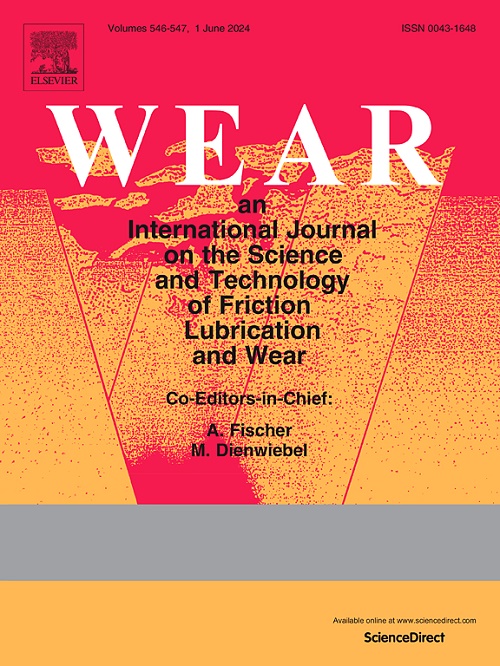Study on the fretting wear performance of oxide layer and Cr coating on zirconium alloy in high-temperature water
IF 5.3
1区 工程技术
Q1 ENGINEERING, MECHANICAL
引用次数: 0
Abstract
Grid-to-rod fretting wear is an important factor causing the fuel failure in nuclear power plants. Accident tolerant fuel (ATF) Cr coating and oxide ceramic coating have been developed to improve the fretting wear performance. In this research, two different oxide layers and Cr coating were prepared on zirconium (Zr) alloy, and the fretting wear performance were studied. The morphology, microstructure, tribo-corrosion reaction, and wear characteristics were analyzed. The oxide layer formed at high-temperature pressurized water (HTPW) has the lowest wear rate of 0.11 × 103 μm3/Nm due to the high hardness and compact structure, which leads to the corresponding friction pairs presenting the highest wear rate of 8.42 × 103 μm3/Nm. The wear depth of oxide layer formed at HTPW is about 5 times lower than that of as-received Zr alloy, and it is also less than the thickness of oxide layer. The oxide layer formed at HTPW after fretting has a larger thickness than the initial state because the plastic deformation layer caused by shear stress can quickly oxidize to zirconia in high-temperature water, and the wear rate of oxide layer is lower than the formation rate of oxide layer. The wear mechanism of two different oxide layers is delamination and abrasive wear, and that of Cr coating is abrasive wear and fatigue wear.
高温水中锆合金氧化层和铬涂层的摩擦磨损性能研究
栅-杆摩擦磨损是导致核电站燃料失效的一个重要因素。为改善摩擦磨损性能,人们开发了事故耐受燃料(ATF)铬涂层和氧化物陶瓷涂层。本研究在锆(Zr)合金上制备了两种不同的氧化物层和铬涂层,并研究了其摩擦磨损性能。研究分析了氧化层的形态、微观结构、三相腐蚀反应和磨损特性。在高温加压水(HTPW)下形成的氧化层由于硬度高、结构紧凑,磨损率最低,为 0.11 × 103 μm3/Nm,相应的摩擦副磨损率最高,为 8.42 × 103 μm3/Nm。在 HTPW 条件下形成的氧化层的磨损深度约为初始 Zr 合金的 5 倍,也小于氧化层的厚度。由于剪切应力引起的塑性变形层在高温水中能迅速氧化成氧化锆,氧化层的磨损速度低于氧化层的形成速度,因此在高温熔化后形成的氧化层厚度比初始状态大。两种不同氧化层的磨损机理是分层和磨料磨损,而铬涂层的磨损机理是磨料磨损和疲劳磨损。
本文章由计算机程序翻译,如有差异,请以英文原文为准。
求助全文
约1分钟内获得全文
求助全文
来源期刊

Wear
工程技术-材料科学:综合
CiteScore
8.80
自引率
8.00%
发文量
280
审稿时长
47 days
期刊介绍:
Wear journal is dedicated to the advancement of basic and applied knowledge concerning the nature of wear of materials. Broadly, topics of interest range from development of fundamental understanding of the mechanisms of wear to innovative solutions to practical engineering problems. Authors of experimental studies are expected to comment on the repeatability of the data, and whenever possible, conduct multiple measurements under similar testing conditions. Further, Wear embraces the highest standards of professional ethics, and the detection of matching content, either in written or graphical form, from other publications by the current authors or by others, may result in rejection.
 求助内容:
求助内容: 应助结果提醒方式:
应助结果提醒方式:


